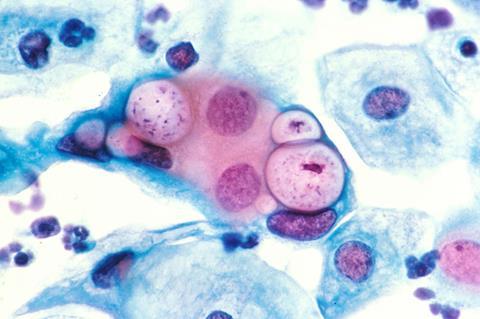In order to find previously unknown substances for the treatment of chlamydial infections, the scientific team led by Georg Stary (Department of Dermatology at MedUni Vienna, CeMM of the Austrian Academy of Sciences) screened a comprehensive compilation of 2,200 active substances.

While 28 of these significantly reduced the growth of chlamydia, one of the substances was even able to prevent infection: “In the mouse model, pentamidine was the only substance we tested that proved to be effective against chlamydia even at very low concentrations, both when applied systemically and locally in the genital area,” reports principal investigator Georg Stary on the results.
Chlamydia depend on host metabolism
Further investigations in the cell model revealed that chlamydia require the metabolism of the host cells for their own growth, which can be used as a new target against chlamydia.
“The substance we identified suppresses the growth of the intracellular bacteria by inhibiting the metabolism of the host cells,” says Georg Stary, explaining the mode of action of pentamidine, an antiprotozoal agent that is already widely used to treat certain infectious diseases. In addition to chlamydia, tests have shown that pentamidine also blocks the growth of Neisseria gonorrhoeae, the pathogen that causes gonorrhoea.
“Lactobacilli as representatives of the vaginal flora, on the other hand, were still able to multiply at a comparable pentamidine concentration, which indicates good tolerance,” emphasises first author Katja Knapp (Department of Dermatology at MedUni Vienna, CeMM).
STI increase
For years, there has been a significant increase in sexually transmitted infections, which can lead to massive problems for those affected due to antibiotic resistance or late complications. There are still no authorised vaccines against common bacterial pathogens such as chlamydia or Neisseria gonorrhoeae.
Several studies have investigated the antibiotic doxycycline for use after sexual contact (post-exposure prophylaxis) to prevent bacterial sexually transmitted diseases in high-risk groups. However, as there is a risk that both the pathogens and strains of the healthy microbiome can develop resistance to doxycycline over time, the newly identified active ingredient pentamidine represents a promising alternative.
“Local application as a prophylaxis for chlamydial infections and possibly also other sexually transmitted infections could be recommended, especially for people with risk behaviour for infection with sexually transmitted pathogens,” says Georg Stary in the run-up to further studies with pentamidine as a template for developing structurally similar substances that specifically target genital pathogens and are suitable for clinical application. In the meantime, the current findings are being pursued by MedUni Vienna for possible patenting.







No comments yet